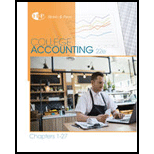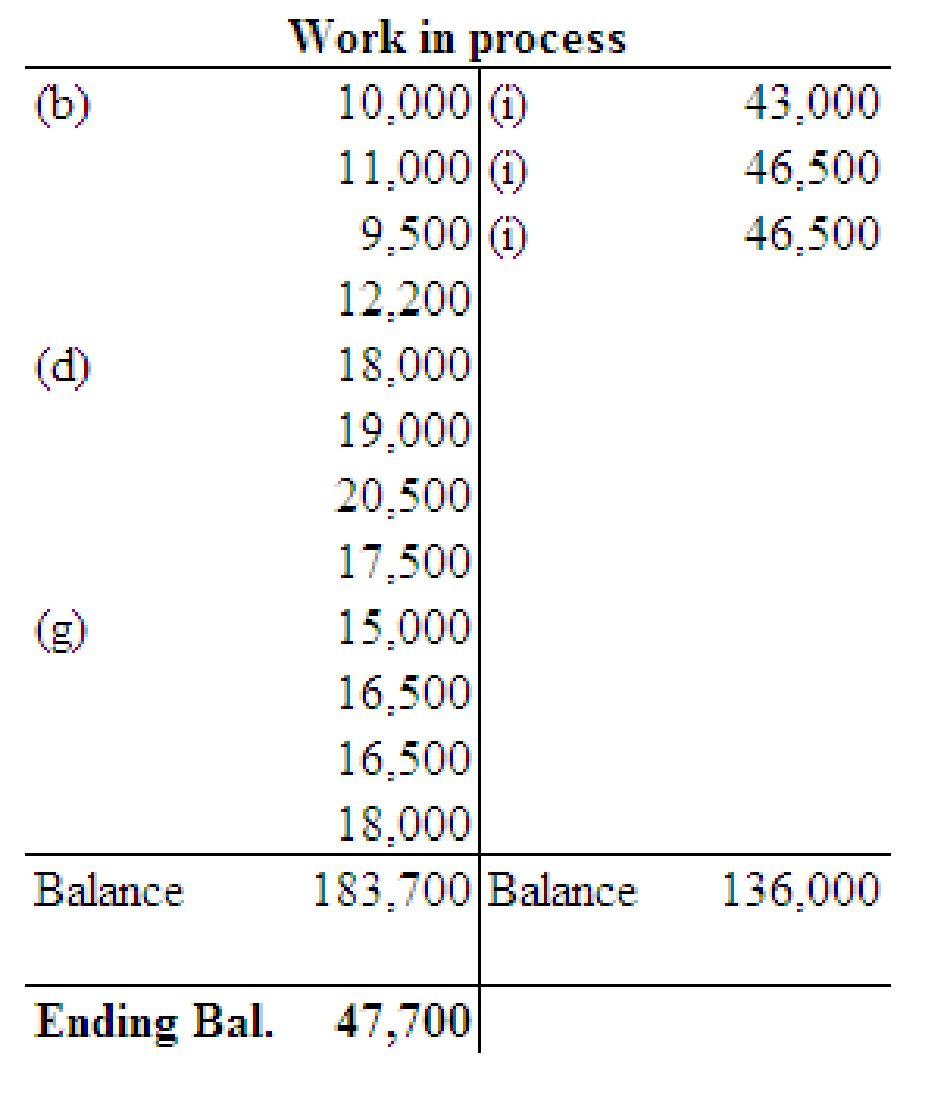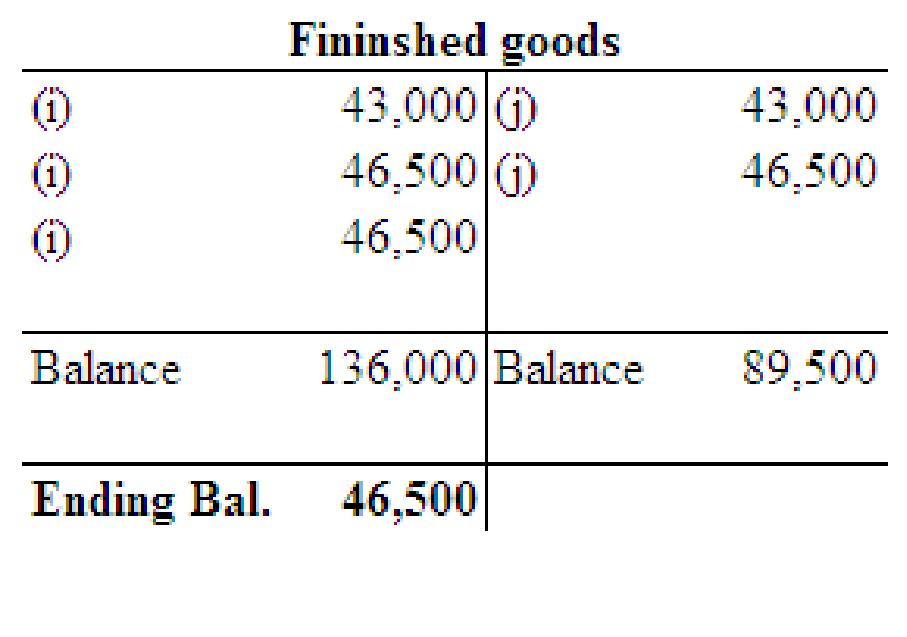
Concept explainers
1.
Prepare general journal entries to record transactions (a) through (k) and make compound entries for (b), (d), and (h), with separate debits for each job.
1.
Explanation of Solution
Job order costing is one of the methods of cost accounting under which cost is collected and gathered for each job, work order, or project separately. It is a system by which a factory maintains a separate record of each particular quantity of product that passes through the factory. Job order costing is used when the products produced are significantly different from each other.
Prepare
| Date | Accounts title and explanation |
Debit ($) |
Credit ($) |
| a. | Material | 45,000 | |
| Accounts payable | 45,000 | ||
| (To record the purchase of materials on account.) | |||
| b. | Work in process | 10,000 | |
| Work in process | 11,000 | ||
| Work in process | 9,500 | ||
| Work in process | 12,200 | ||
| Materials | 42,700 | ||
| (To record issuance of direct materials for the job: job no.201,202,203,204) | |||
| c. | Factory | 7,500 | |
| Materials | 7,500 | ||
| (To record the issuance of indirect materials) | |||
| d. | Work in process | 18,000 | |
| Work in process | 19,000 | ||
| Work in process | 20,500 | ||
| Work in process | 17,500 | ||
| Wages payable | 75,000 | ||
| (To record direct labor incurred for the job: job no.201,202,203,204) | |||
| e. | Factory overhead | 11,000 | |
| Wages payable | 11,000 | ||
| (To record the indirect labor charged to production) | |||
| f. | Factory overhead | 7,000 | |
| Cash | 7,000 | ||
| (To record the payment of electricity bill, heating oil, and repairs bills for the factory and charge made to production) | |||
| g. | Factory overhead | 40,000 | |
| | 40,000 | ||
| (To record the depreciation expense on factory equipment) | |||
| h. | Work in process | 15,000 | |
| Work in process | 16,500 | ||
| Work in process | 16,500 | ||
| Work in process | 18,000 | ||
| Factory overhead | 66,000 | ||
| (To record applied factory overhead to the job: job no.201,202,203,204) | |||
| i. | Finished goods (Product C) | 43,000 | |
| Work in process | 43,000 | ||
| (To record the transfer of Job no. 201 to Product C) | |||
| Finished goods (Product D) | 46,500 | ||
| Work in process | 46,500 | ||
| (To record the transfer of Job no.202 to Product D) | |||
| Finished goods (Product E) | 46,500 | ||
| Work in process | 46,500 | ||
| (To record the transfer of Job no.203 to Product E) | |||
| j. | Accounts receivable | 47,000 | |
| Sales | 47,000 | ||
| (To record sale of product C) | |||
| Cost of goods sold | 43,000 | ||
| Finished goods (Product C) | 43,000 | ||
| (To record cost of goods sold on finished goods of Product C) | |||
| Accounts receivable | 49,000 | ||
| Sales | 49,000 | ||
| (To record sale of product D) | |||
| Cost of goods sold | 46,500 | ||
| Finished goods (Product D) | 46,500 | ||
| (To record cost of goods sold on finished goods of Product D) | |||
| k. | Factory overhead | 500 | |
| Cost of goods sold (2) | 500 | ||
| (To record cost of goods sold) |
(Table 1)
Working note:
(1) Calculate the actual factory overhead:
(2) Calculate the cost of goods sold:
2.
2.
Explanation of Solution
Post the entries to the work in process and finished goods T accounts and determine the ending balances in these accounts.


3.
Compute the balance in the job cost ledger and verify whether the balance agrees with that in the work in process control account.
3.
Explanation of Solution
The balance of the job cost ledger (Job No.204) is $47,700
Want to see more full solutions like this?
Chapter 26 Solutions
College Accounting, Chapters 1-27
- The actual cost of direct labor per hour is $16.25 and the standard cost of direct labor per hour is $15.00. The direct labor hours allowed per finished unit is 0.60 hours. During the current period, 4,500 units of finished goods were produced using 2,900 direct labor hours. How much is the direct labor rate variance? A. $3,625 favorable B. $3,625 unfavorable C. $4,350 favorable D. $4,350 unfavorablearrow_forwardOn January 1 of the current year, Piper Company issues a 4-year, non-interest-bearing note with a face value of $8,000 and receives $4,952 in exchange. The recording of the issuance of the note includes a: a. credit to Notes Payable for $4,952. b. credit to Discount on Notes Payable for $3,048. c. debit to Discount on Notes Payable for $3,048. d. debit to Cash for $8,000.arrow_forwardPLease helparrow_forward
- What is the budgeted total cost of direct materials purchases?arrow_forwardHy expert provide answer with calculationarrow_forwardDuring September, the assembly department completed 10,500 units of a product that had a standard materials cost of 3.0 square feet per unit at $2.40 per square foot. The actual materials purchased consisted of 22,000 square feet at $2.60 per square foot, for a total cost of $57,200. The actual material used during this period was 25,500 square feet. Compute the materials price variance and materials usage variance.arrow_forward
- Bluesy Electronics recorded the following financial data: Net Sales $720,500 Average Inventory at Cost = $80,200 Gross Margin Percentage = 42% Calculate the GMROI.arrow_forwardNeed help this question solutionarrow_forwardXYZ Company has a gross profit margin of 0.30, an operating profit margin of 18%, a total asset turnover ratio of 2.0x, and cost of goods sold of $700,000. The company's tax rate is 35%, and it has no debt. Calculate XYZ Company's Return on Assets (ROA).arrow_forward
 Principles of Cost AccountingAccountingISBN:9781305087408Author:Edward J. Vanderbeck, Maria R. MitchellPublisher:Cengage Learning
Principles of Cost AccountingAccountingISBN:9781305087408Author:Edward J. Vanderbeck, Maria R. MitchellPublisher:Cengage Learning College Accounting, Chapters 1-27AccountingISBN:9781337794756Author:HEINTZ, James A.Publisher:Cengage Learning,
College Accounting, Chapters 1-27AccountingISBN:9781337794756Author:HEINTZ, James A.Publisher:Cengage Learning, College Accounting, Chapters 1-27 (New in Account...AccountingISBN:9781305666160Author:James A. Heintz, Robert W. ParryPublisher:Cengage Learning
College Accounting, Chapters 1-27 (New in Account...AccountingISBN:9781305666160Author:James A. Heintz, Robert W. ParryPublisher:Cengage Learning Managerial AccountingAccountingISBN:9781337912020Author:Carl Warren, Ph.d. Cma William B. TaylerPublisher:South-Western College PubPrinciples of Accounting Volume 2AccountingISBN:9781947172609Author:OpenStaxPublisher:OpenStax College
Managerial AccountingAccountingISBN:9781337912020Author:Carl Warren, Ph.d. Cma William B. TaylerPublisher:South-Western College PubPrinciples of Accounting Volume 2AccountingISBN:9781947172609Author:OpenStaxPublisher:OpenStax College Managerial Accounting: The Cornerstone of Busines...AccountingISBN:9781337115773Author:Maryanne M. Mowen, Don R. Hansen, Dan L. HeitgerPublisher:Cengage Learning
Managerial Accounting: The Cornerstone of Busines...AccountingISBN:9781337115773Author:Maryanne M. Mowen, Don R. Hansen, Dan L. HeitgerPublisher:Cengage Learning





